How To Rebut The 2005 PDRS (2 of 2)
by Stephen Schneider, principal at ScanFiles, Inc. and DocuCents
INTRODUCTION
When introduced in January of 2005, the 2005 PDRS reduced overall benefits by over 50%. This is not according to some liberal “expert” but according to the Department of Industrial Relations (CHSWC) in a report signed by Christine Baker and based on data formulated by none other than Frank Neuhauser. This reduction in PD benefits wasn’t because of changes in the law in SB 899… the same CHSWC study says the ERRORS made when formulating that 2005 schedule caused that measured reduction ALL ON ITS OWN. And here’s the real news – the weak 2005 schedule is subject to rebuttal and that same study includes all the necessary rebuttal evidence.
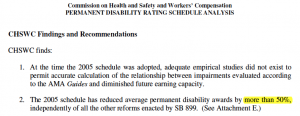
I hope that applicant attorneys will pay attention to this blog post and read through to the end despite the complicated nature of it. If nothing else, this post represents the possibility that revenue in their own practice could be increased by that same ratio.
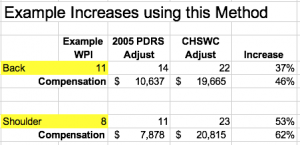
This isn’t about “gaming” the system or reaching for benefits that aren’t due injured workers under the law. I’m talking about simply holding the 2005 PDRS accountable for its flaws and making sure that every injured employee’s percentage of permanent disability is measured (and paid) accurately under existing law.
REVIEW
Last week, we reviewed the recent Dahl decision, which clarifies and narrows the rebuttal methods described in Ogilvie III. We reviewed the history of the PDRS rebuttal methods from Costa, through Boughner and all three Ogilvie decisions. We are now ready to look at one of the general methods STILL available to rebut the Schedule on most any case still subject to the 2005 PDRS.
What we know at this point is the Court Of Appeal encourages parties to bring rebuttal evidence to prove a more appropriate percentage of permanent disability than is provided under the 2005 schedule… but what you may be wondering after Dahl is exactly HOW?
REBUTTAL METHOD OVERVIEW
I’ve had several theories and proposed methods for rebutting the 2005 PDRS that I’ve come up with over the years, but never published. The method I propose below is not the ONLY method available, but I think it is the BEST. I believe this method is SIMPLE enough and STRONG enough that it should be considered by every applicant attorney on every case. Here is WHY I think this is the BEST method available today for rebutting the 2005 PDRS under Ogilvie III:
- This method requires no “expert” be hired to do the math
- The data was produced by the Department of Industrial Relations (DIR) so it can be put into evidence and relied upon by the appeals board under Labor Code Section 5703(e)
- CHSWC has already provided a simple CHART that can be used for the calculation
- This method gives back “most” of what was taken away by the errors in the 2005 schedule
- This method does not “game” the data or formula for either side – it’s a straight empirical calculation of the employee’s LONG TERM percentage of permanent disability.
With that said, the method is not without its friction points and drawbacks. I may discuss the pros and cons of some of these in future blogs, but for now, I just want to get this “out in the world” for comment and discussion.
THE METHOD
The method involves a set of ALTERNATIVE ADJUSTMENT FACTORS that can be used in place of the adjustment factors provided in Table A of the 2005 PDRS. These alternative adjustment factors PROPERLY apply a Labor Code Section 4660 “formula” that aggregates the long term loss of income from RAND for each type of AMA Guides impairment category. That’s the only modification of the current rating process that this method changes. Judges can simply instruct the DEU rater to use the adjustment factor from the CHSWC chart, as opposed to the factors in Table A of the schedule, and the resulting rating will come the closest to the legislature’s directives in LC 4660 as we have available today.
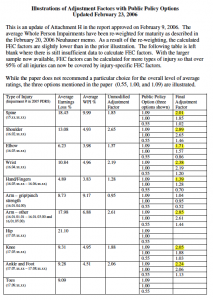
HOW TO USE THE ALTERNATIVE ADJUSTMENT FACTORS
These alternative adjustment factors come straight out of an official CHSWC report, and was written by a conservative researcher who co-authored the 2003 Interim Report from RAND that is incorporated into LC 4660 (Frank Neuhauser). Because it’s a published report from the Department of Industrial Relations (CHSWC), this report may be introduced as evidence and relied upon by the appeals board under Labor Code Section 5703(e). All you need to do as the attorney for a party is make the arguments for using these alternative adjustment factors and then move the WCJ to instruct the DEU rater to perform an otherwise “normal” 2005 PDRS rating, but swapping in these alternative adjustment factors. See California Code of Regulations Section 10602, and also see the Blackledge En Banc decision for authority of WCJ’s for giving such instructions to the DEU “expert” rater. The act of rating is very simple using this method. That’s the beauty of it… the complexity is in the lawyering.
No Experts Required: No “experts” are required or used under this method – which is exactly what the Court Of Appeal seems to be looking for in Ogilvie III to provide a system that promotes consistency, uniformity, and objectivity in the rating process. This method merely corrects the PDRS to ensure it’s accurate application. (See top of page 11 of Ogilvie III.)
This CHSWC report has been available since February of 2006, but as far as I know, nobody has used it to rebut the schedule. At least, no WCAB En Banc decisions or Court Of Appeal cases have shown up based on this method.
At the bottom of this post I discuss why this 2006 data continues to be the best available data for rebutting the schedule. See Addendum A.
OGILIVIE III REQUIRES AN ERROR IN THE SCHEDULE BE SHOWN
The Court Of Appeal told us in Ogilvie III how to rebut the schedule. In the conclusion of the decision, on page 15, the Court states: “The application of the rating schedule is not rebutted by evidence that an employee’s loss of future earnings is greater than the earning capacity adjustment that would apply to his or her scheduled rating due to nonindustrial factors. Rather, to rebut the application of the rating schedule on the basis that the scheduled earning capacity adjustment is incorrect, the employee must demonstrate an error in the earning capacity formula, the data or the result derived from the data in formulating the earning capacity adjustment.” [Emphasis added]
At the bottom of page 9 the Court Of Appeal in Ogilvie III states: “A challenge to an employee’s presumptive disability rating thus appears to remain permissible on the basis that the schedule, or one of its component factors, was incorrectly calculated or applied.” These are key terms that we must prove.
REBUTTAL MUST INCLUDE THE USE OF RAND WAGE LOSS DATA:
At the bottom of page 8 and top of page 9 of Ogilvie III, the Court Of Appeal makes it clear that to rebut the Schedule one MUST use “a numeric formula based on empirical data and findings as developed by the RAND institute in their 2003 Interim Study. In considering the Legislature’s intent to provide consistency. uniformity and objectivity in permanent disability awards, we see nothing ambiguous or unclear in Section 4660’s directive that the earning capacity adjustment factor ‘shall be’ the numeric formula based upon the RAND Institute’s report. It must be initially applied.” (See top of page 9.)
So, one thing we know for sure is the Proportional Wage Loss Data used in any rebuttal rating must be based on the “data” provided by RAND in the 2003 Interim Report on Permanent Disability. The Proportional Wage Loss data in the CHSWC 2006 study is in fact based on the same data RAND used in their 2003 study. See the CHSWC report itself for more discussion on that topic.
A FACTUAL ERROR IN THE APPLICATION OF A FORMULA OR PREPARATION OF THE SCHEDULE IS DEFINED BY THE COURT OF APPEAL
The Court Of Appeal goes on to state that “cases have always recognized the schedule to be rebutted when a party can show a factual error in the application of a formula or the preparation of the schedule.” In the next paragraph, the court goes on to say, “The possibility an employee can demonstrate such an error in the earning capacity adjustment factor is more than theoretical, particularly in cases like this one involving a back injury.” The Court goes on to discuss the fact that the data provided by RAND to the DWC when formulating the 2005 Schedule was flawed and biased. On page 10 the court said:
For example, one of the challenges faced by the RAND group was that the data previously assembled to consider earnings loss attributable to certain injuries was categorized by descriptions used by the California Permanent Disability Rating System, while Senate Bill No. 899 requires injury descriptions based on the American Medical Association Guides. (Working Paper at p. 7.) The descriptions are quite different in practice, and at the time the future earning capacity adjustments were established, there was no direct link between the data used by RAND and the American Medical Association Guides. (Ibid.) An ideal system would combine information on earnings losses with actual American Medical Association Guide ratings.
… And there is the ANSWER to rebutting the schedule. The fact is, ALL of the FEC Adjustment Factors used in the 2005 schedule are flawed by this same LACK OF A DIRECT LINK IN THE DATA to actual AMA Guides impairments… RAND lacked average AMA rating data across all impairments when they delivered their 2004 DATA PAPER to the DWC that was used to formulate the schedule.
CHSWC reiterates this exact same argument made by the Court Of Appeal in Ogilvie III, and lays the foundation for this rebuttal method. This is a KEY point.
DO NOT MAKE THE SAME MISTAKE AS THE EMPLOYEE IN COSTA…
The Court then goes on to say something very important in light of this argument and the findings of the Costa case, wherein the applicant failed because they tried to prove the Schedule was entirely INVALID based on the “no direct link in the data” argument. In Ogilvie III the court says, “A challenge to the ratings schedule on the basis that there was a factual error in the calculation of one of its component factors, or it was incorrectly applied in a particular case does not undermine the Schedule’s consistency, uniformity and objectivity. (§ 4660, subd. (d).) It merely serves to correct it or ensure its accurate application.” [emphasis added.]
What the Court Of Appeal is telling us is that rebutting the schedule on the basis that there was no direct link to the AMA Guides impairments in the data used in the formulation of the FEC factors in the schedule does not invalidate the schedule in general, but can be used to rebut the schedule when more appropriate data is available. To me, this is a major point, because we have to stay clear of arguments already made and lost in the Costa case. The schedule is still valid… it just has errors included that we can now correct.
PROVING THE 2005 SCHEDULE INCLUDES AN ERROR IN THE FORMULA AND THAT ONE OF ITS COMPONENT FACTORS WERE INCORRECTLY APPLIED
The method I am describing here is based on a proposal that the Department Of Industrial Relations (CHSWC) sent to the Legislature on February 23, 2006 (click here to read). This was a little over a year after the 2005 PDRS had been adopted by the DWC. The report was signed by Christine Baker, who is now the Director of the Department of Industrial Relations (DIR). Ms. Baker was the Executive Officer of CHSWC at the time she signed this report.
The report gives us the evidence we need to prove the errors in the Schedule, and coincides perfectly with the arguments put forth by the Court Of Appeal that I discussed above.
ERROR # 1:
On page 3 of the report, under the heading “Impact of the 2005 Schedule for Rating Permanent Disabilities“, it discusses the environment surrounding the creation and adoption of the 2005 PDRS. It states: “At that time, there was no satisfactory way to predict how the percentages of impairment evaluated under the AMA Guides would correspond to the reduction in injured workers’ earning capacity.” [Emphasis added.]
The argument here is that Labor Code 4660(b)(2) requires that an employee’s diminished future earning capacity shall be a numeric formula based on empirical data and findings that aggregate the average percentage of long-term loss of income resulting from EACH TYPE OF INJURY [emphasis added] for similarly situated employees… (stay with me here)… And the term “INJURY” is defined in (b)(1) as incorporating “the descriptions and measurements of physical impairments and the corresponding percentages of impairments published in the American Medical Association (AMA) Guides to the Evaluation of Permanent Impairment (5th Edition).” In other words, the 2005 PDRS used the ratio of ratings over losses based on the WRONG rating system when formulating the Table A FEC adjustment factors, and therefore includes an ERROR in the formula defined by Labor Code Section 4660.
Conclusion: PDRS has an error in its formula because it does NOT properly CORRESPOND the RAND wage loss data with average AMA Guides-based ratings as part of its formula. Instead, the 2005 PDRS aggregates the RAND wage loss data with the old 1997 schedule’s average ratings, which have no correlation to the AMA Guides descriptions and measurements. This is the exact argument put forth by the Court Of Appeal in paragraph 2 of page 10 in Ogilvie III as a valid argument to rebut the schedule. The average “injury” data was incorrectly applied as one of the component factors in formulating the PDRS.
ERROR # 2:
In the 2006 report, CHSWC goes on to say on page 3, paragraph 3, “The first year of experience under the 2005 revision of the Schedule for Rating Permanent Disabilities demonstrates that the 2005 schedule reduces permanent disability benefits by more than 50% compared to the pre-2005 schedule, apart from the other changes made by SB 899. This reduction is observed by comparing the ratings in the population of cases rated under the 2005 schedule with the ratings for a similar population under the pre-2005 schedule. These cases provide a valid measure of the performance of the system, and because it is unlikely that the severity of injuries or the economic consequences to injured workers changed when the new schedule took effect, this reduction is due to the rating schedule itself. The dollar values of the awards are calculated by applying the 2005 laws to both the 2005 schedule ratings and the pre- 2005 comparison ratings, so the 50% reduction is entirely due to the rating schedule.“
At this point, it should be pointed out to any trier of fact that the VALUE of the benefits provided to employees who are injured is SET and calculated under Labor Code Section 4658 (a.k.a. the “money chart”), and NOT in Section 4660. The MEASUREMENT of the employee’s percentage of permanent disability as defined by LC 4660 should not be “adjusted” to save employer’s money on their workers compensation costs… if the legislature intends to REDUCE BENEFITS it will do so in Labor Code Section 4658. In fact, the legislature DID change the delivery and VALUE of benefits in LC 4658(d) as part of SB 899. My point here is the 2005 schedule is a measurement tool only, and should make the intended measurement as ACCURATELY as possible. It is not a political tool to be used to adjust the value of benefits paid to injured workers for permanent disability. THAT role is defined in Labor Code Section 4658 and is exclusively the domain of the legislature.
Okay, getting back to the error… on page 5, under “CHSWC Findings And Recommendations”, item number 1 states “At the time the 2005 schedule was adopted, adequate empirical studies did not exist to permit accurate calculation of the relationship between impairments evaluated according to the AMA Guides and diminished future earning capacity.” Again, this is the exact argument the Court Of Appeals gave us in Ogilvie III to rebut the schedule.
On the same page, under “Recommendations”, the THIRD bullet states, “A method to formulate new FEC factors for each type of injury based on average earnings losses and on observed impairment ratings, with the new FEC factors to be adopted in the revised schedule in place of the eight FEC factors in the 2005 schedule.” So, CHSWC “recommends” that these alternative adjustment factors be used in place of Table A in the 2005 PDRS.
The point is, the DIR (through CHSWC) states in their own report that at the time the schedule was written, adequate empirical studies did NOT exist to permit accurate calculation of the relationship between impairments and the AMA Guides, and AS A RESULT benefits were reduced by more than 50% entirely because of the effects of the 2005 Permanent Disability Schedule, THAT is a showing of “a factual error in the application of a formula or the preparation of the schedule” which is what the Court Of Appeal said was needed to rebut the schedule in Ogilvie III. The declaration of this error wasn’t some hired “expert” for one of the parties, but is the Department of Industrial Relations itself, and was signed by the now acting Director of the DIR, Christine Baker.
CONCLUSION
I’m sure there are many other arguments a good lawyer could glean from this CHSWC Report to convince any WCJ, the WCAB and the Court Of Appeal that the 2005 PDRS has “a factual error in the application of a formula or the preparation of the schedule”, and that “one of its component factors was incorrectly calculated or applied.” This is what the Court Of Appeal requires before the employee’s presumptive rating from the 2005 PDRS can be rebutted. The Court Of Appeal in Ogilvie III gave us these EXACT arguments on page 10 of the decision… so run with them.
CHOOSING THE MOST APPROPRIATE ALTERNATIVE ADJUSTMENT FACTOR IN THE CHSWC REPORT
The 2006 CHSWC report is complicated to read and comprehend because it starts off with high level findings and recommendations, then abruptly moves into a collection of several interim reports, then come lots of public comments, and then a final addendum that addresses the concerns in the public comments. All this is put together as one document (PDF). For the most part, what we are concerned with is the final couple of pages in the PDF file, which is the updated list of alternative adjustment factors that would replace those adjustment factors in Table A of the PDRS.
In its proposed table of alternative adjustment factors, CHSWC introduces yet another complication because it offers up THREE different factors for EACH injury type. There is a 1.0 factor, a 1.09 factor, and a .55 factor. I have highlighted the 1.09 factors in yellow in the image, below. CHWC called these “Public Policy Options”. Keep in mind this report was going to the legislature, and was meant to guide POLITICS. This complicates the use of the chart because a WCJ, the WCAB and the Court Of Appeal will all be faced with making the “Public Policy Decision” in place of the legislature. This is unfortunate, but thankfully all but one of the options corrects the 2005 PDRS ratings to be much closer to actual losses than it does now. Below, I’ve provided my personal opinion on the appropriateness of each option. Hopefully, my comments feed your imagination to make your own arguments before the courts.

0.55 PUBLIC POLICY OPTION:
Let’s start with the 0.55 “option”, which can be thrown out easily. This REDUCES all the measurements of percentage of permanent disability to correspond with the AVERAGE of all ratings produced under the faulty 2005 PDRS… the one that caused over-50% reduction in overall benefits through the errors discussed here. Therefore, this one should be easy to get thrown out. Nothing in LC 4660 as amended by SB899 required the administrative director to deliberately reduce over-all percentages of permanent disability by over 50% through various errors in the formula, so we certainly would not want to adjust to that average now.
1.0 PUBLIC POLICY OPTION:
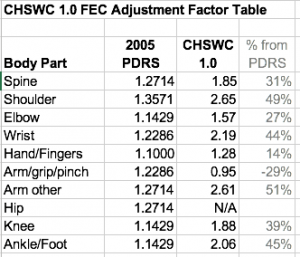
As you can see in the chart above, this Public Policy Option makes up for a lot of that 50% ERROR in overall benefit delivery that the 2005 PDRS caused. This set of alternative adjustment factors convert the AMA Guides WPI% to the exact 3-year average Wage Loss % measured by RAND in their 2003 Interim Study. While that may seem to do the best job of hitting the target of aggregating average wage loss with each average WPI%, it NEGLECTS the requirement in LC Section 4660(b)(2) to aggregate the average WPI% with LONG TERM loss of income.
See page 6 of RAND’s 2004 Interim Report, Table 1, and the paragraph just above Table 1, wherein RAND defines “Long Term economic prospects of injured workers” to be 10-years. The wage loss data studied by RAND in this report was only calculated at THREE years because RAND was limiting their focus on creating adjustment factors that would EQUALIZE the ratio of rating over losses ACROSS BODY PARTS, and was not meant to change the LONG TERM ADEQUACY level of the PD benefits in general. Remember, the 2003 Interim report by RAND was only looking to adjust the old 1997 schedule for equity across body parts – NOT change the adequacy of the benefits being paid to injured workers. In fact, the 2003 RAND Interim report showed that average benefits paid to California employees was below several other states, and “barely” adequate already.
What this means is that changes to the FORMULA used to MEASURE the employee’s percentage of permanent disability should NOT be “adjusted” to reimburse the employee for ONLY his/her 3-YEAR LOSSES… it must consider the employee’s “LONG TERM” losses while taking into account their AMA Guides WPI% as required by the clear language in Labor Code 46690(b)(2). To account for the employee’s LONG TERM losses one must use the 1.09 method described next.
1.09 PUBLIC POLICY OPTION (MOST ACCURATE TO LC 4660)
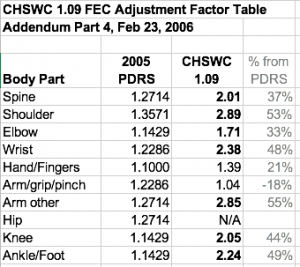
As you can see from the chart above, the 1.09 Public Policy Option comes the closest to CORRECTING THE ERRORS in the 2005 PDRS that caused benefits to be reduced by more than 50%. What this option does is aggregate the average WPI% ratings with the average 3-Year Wage Loss data from RAND and then adjust that UPWARDS to account for the LONG TERM (10-year) adequacy level of benefits provided under the (barely adequate) system prior to SB 899. Again, this is using RAND “findings” right out of the 2003 Interim Report.
This 1.09 alternative adjustment factor, which was one of the options suggested by CHSWC does the BEST job of providing “...a numeric formula based on empirical data and findings that aggregate the average percentage of LONG-TERM loss of income resulting from each type of INJURY for similarly situated employees.” [Emphasis added.]
CONCLUSION
At the time Ogilvie III came out, my father Warren Schneider and I were performing Ogilvie II ratings, under the old WCAB method for rebutting the schedule. We published charts, a sample pleading, and other tools to help parties rebut the faulty 2005 schedule. The Court of Appeal shut down that method in July of 2011. Four years have already passed since that time, and injured workers have been continuing to receive only 50% of the benefits owed them under Labor Codes 4660 and 4658 – all because of the errors in formulating the 2005 PDRS. I believe that WCJs, the WCAB and the Court of Appeal would all fully support rebuttal evidence that would provide ACCURATE permanent disability benefits to injured workers under existing law, but the method can’t be based on the use of expensive and inconsistent “dueling experts”. To rebut the schedule, you must use a “formula” that aggregates average LONG TERM loss of income from RAND with the average percentages from each AMA Guides Impairment category, and adjusts the employee’s individual WPI% according to that FORMULA.
As attorneys, you have what you need. In fact, you’ve had it since February 2006. I urge you to take this proposal seriously and come up with a rebuttal rating for each and every client that you represent who still falls under the 2005 PDRS. Time is running out.
I would LOVE to hear from you on what you think of my rebuttal method discussed here. You can reach me at Stephen@ScanFiles.com, or you can reply to this blog post. I would gladly provide future posts that address your criticisms or concerns with what I’ve proposed here.
CLICK HERE FOR ADDENDUM A - WHY THE 2006 CHSWC REPORT CONTINUES TO BE THE BEST AVAILABLE DATA FOR REBUTTING THE SCHEDULE
There are several other studies and data provided by various groups that are available, including later studies by the DWC, CHSWC, and RAND. All of these studies provide more RECENT data that COULD be used to provide a similar type of rebuttal rating. HOWEVER, none of these studies provide aggregated un-adjusted AMA Whole Person Impairment percentages that can be used to formulate accurate alternative FEC adjustment factors to REPLACE the adjustment factors in Table A of the PDRS. All of the other data is either FINAL ratings after being run through the formulas in the 2005 PDRS, or rating data under the 1997 rating system.
While the rating data in the 2006 CHSWC report was “preliminary”, and the sample sizes small, they are adequate according to CHSWC/DIR. Therefore, it is appropriate data to be used to rebut the 2005 schedule, and is dramatically more accurate than what was used to formulate the schedule itself. Of that, there can be NO QUESTION.
While one could argue the data is old, out of date, and preliminary, it continues to be the ONLY data that will provide such a simple method of rebutting the schedule… and one that requires no additional or complicated math formulas, or dueling experts to calculate. CHSWC provided us a chart of FEC adjustment factors that can be easily swapped in the rating process for Table A, and do the BEST job of correcting the errors in the current version of the 2005 PDRS.
If the DIR wants us to have more up-to-date and accurate data, all they have to do is give it to us. They certainly have it. Unfortunately, the DIR is a political machine run by the Governor, and allowing employees to receive any increase in benefits – even if just to make up for a previous unfair and un-legislated employer advantage – is a political HOT BUTTON that both governors of California since the passage of SB 899 have been unwilling to correct.
That responsibility unfortunately falls on you, Mr. Applicants Attorney. Good luck out there!
